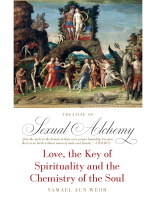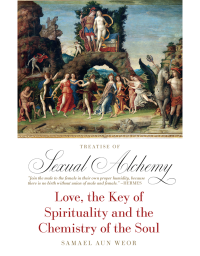Alchemy:
- From Al (as a connotation of the Arabic word Allah: al-, the + ilah, God) means “The God.” Also Al (Hebrew) for “highest” or El “God.”
- Chem or Khem is from kimia (Greek) which means “to fuse or cast a metal.” Also from Khem, the ancient name of Egypt.
- The synthesis is Al-Kimia: “to fuse with the highest” or “to fuse with God.”
“To most of us the word ‘alchemy’ calls up the picture of a medieval and slightly sinister laboratory in which an aged, black-robed wizard brooded over the crucibles and alembics that were to bring within his reach the Philosophers’ Stone, and with that discovery the formula for the elixir of life and the transmutation of metals. But one can scarcely dismiss so lightly the science--or art, if you will--which won to its service the lifelong devotion of men of culture and attainment from every race and clime over a period of hundreds, or, indeed, thousands, of years, for the beginnings of alchemy are hidden in the mists of time. Such a science is something far more than an outlet for a few eccentric old men in their dotage.What was the motive behind the constant strivings, the never-failing patience in the unravelling of the mysteries, the tenacity of purpose in the face of persecution and ridicule through the countless ages that led the alchemist to pursue undaunted his appointed way? Something far greater, surely, than a mere vainglorious desire to transmute the base metals into gold, or to brew a potion to prolong a little longer this earthly span, for the devotees of alchemy in the main cared little for these things. The accounts of their lives almost without exception lead us to believe that they were concerned with things spiritual rather than with things temporal. Rather were these men inspired by a vision, a vision of man made perfect, of man freed from disease and the limitations of warring faculties both mental and physical, standing as a god in the realization of a power that even at this very moment of time is lying hidden in the deeper strata of his consciousness, a vision of man made truly in the image and likeness of the one Divine Life in all its Perfection, Beauty, and Harmony.” — Archibald Cockren, Alchemy Rediscovered and Restored (1941)
In the Judeo-Christian scriptures, the two trees of the Garden of Eden symbolize the two essential branches of all knowledge. To succeed in spiritual development, it is essential to study both trees, since they share their roots.
The Tree of Life is the science of Kabbalah, the science of numbers.
The Tree of Knowledge (Hebrew, דעת Da’ath) is the science of sexuality, which is known in the east as Tantra, and hidden in the West as “Alchemy.”
This book is primarily about Alchemy, the Tree of Knowledge, but references the Tree of Life throughout since you cannot understand one without the other.
Alchemy was known and practiced by the ancient Egyptians, Aztecs, Mayans, Chaldeans, Greeks, Tibetans, Indians, Zen and Chan Buddhists, Zoroastrians, Sufis, and many, many more. All kept it secret.
In Egypt, the mysteries of alchemy were hidden in the myths and symbols of Osiris and Isis. The Egyptian religion was alchemical. We in the West learned about the two trees in Eden by reading Bereshit / Genesis in the Bible or Torah: those stories were written by Moses, who was raised as an Egyptian priest. All of the books of Moses are Egyptian, alchemical, symbolic, and contain vast knowledge. However, before 1950, that knowledge was never revealed publicly. Anyone who dared to reveal it was killed. That changed in 1950 with the mission entrusted to Samael Aun Weor, the first person authorized to show humanity the reality of the esoteric teachings hidden in all religions. With the keys in this book, you can unlock that knowledge, and the meaning of this warning:
“And Jehovah Elohim commanded the man, saying, “Of every tree of the garden thou mayest freely eat, but of the tree of the דעת knowledge of טוב (towb: goodness, purity) and רע (ra: pollution, impurity), thou shalt not eat of it: for in the day that thou eatest thereof thou shalt surely die.” —Genesis 2:16-17
To understand what this means is the difference between becoming an angel or as a demon. Although most modern bibles render the Hebrew words Towb and Ra as “good” and “evil,” the actual meanings are “goodness” and “impurity.” The symbolic tree of knowledge has two potential outcomes: purity or impurity. Alchemy creates, but what we create depends upon how we act with the Tree of Knowledge.
That tree (Alchemy) provides the method to transform the ignorant human being into the ultimate fulfillment of human existence: a purified soul, an angel, a buddha, a master, free of suffering and marked by the spontaneous expression of pure and selfless compassion. Few accomplish it. Alchemy is most known for greedy gold-seeking “chemists,” people desperate to get rich, but who died as failures. Nevertheless, there were a handful of real alchemists, men and women who learned how to conquer death, spontaneously generate precious metals and gems, and cure incurable diseases; most of all, they were known for creating the Philosopher’s Stone: a magical item which could work miracles and bestow eternal life. These stories are identical to the tales of yogis and monks of the East who walked upon the winds, healed the sick, and performed all manner of miraculous acts. Such powers are superficial expressions of the divine power that emerge within the prepared human being. Such powers are actually meaningless, and are mere “side effects” of the real purpose of self-development: the understanding of reality, and ability to genuinely help those who suffer. If you need an example to clarify, study the lives of Jesus, Moses, Krishna, Buddha, etc. Each of them had the Philosopher’s Stone, and used it to help others, just as any real alchemist did.
The Philosopher’s Stone is related with the stone of Jacob.
“And Jacob set up a pillar in the place where he talked with [God], even a pillar of stone: and he poured a drink offering thereon, and he poured oil [שמן shemen] thereon.” —Genesis 35:14
The Philosopher’s Stone is related with the “foundation stone” mentioned repeatedly in the Christian Gospels.
“The stone which the builders disallowed, the same is made the head of the corner, and a stone of stumbling, and a rock of offence.” —1 Peter 2: 7-8
The Philosopher’s Stone is created by perfecting our own rough and unworked stone, the Brute Stone of the primeval Masons.
The secret wisdom of the Tree of Knowledge reveals the science to develop the Philosopher’s Stone, or in other words, how to return to Eden.
Both the Western branch (Alchemy) and the Eastern branch (Tantra) of this ancient science have been fractured into many variations and movements. The pure ones have generally gone underground or “disappeared” from view, either due to intense persecution or outright murder. In their wake there have appeared many degenerated sects of who sought only to feed desires, thereby giving birth to many of the most widespread “spiritual” movements of today. That is why most of what people believe about Alchemy and Tantra is mistaken.
From this you can see that we can categorize all forms of Alchemy and Tantra into three types: White, Grey, and Black.
The White form seeks to transform the impure into perfect purity, creating an “angel.”
The Black form seeks to increase desire, lust, pride and power, creating a “demon.”
The Grey form is a mix of the two, but it inevitably becomes Black, because desire—the ego—is so heavy in mankind.
To enter into the positive and uplifting realm of White Tantra requires exact science. The method to return to God is not negotiable: after all, divinity cannot mix with impurity.
“...if this perfection might be mixed with the imperfect, the imperfect should not be perfected with the perfect, but rather their perfections should be diminished by the imperfect, and become imperfect.” —Roger Bacon, Mirror of Alchemy
Therefore, there is only one genuine way to ascend: by means of perfection. As the great Kabbalist and Alchemist Jesus of Nazareth said,
“Be ye therefore perfect, even as your Father which is in heaven is perfect.” —Matthew 5:48
“Enter ye in at the strait gate: for wide is the gate, and broad is the way, that leadeth to destruction, and many there be which go in thereat:
“Because strait is the gate, and narrow is the way, which leadeth unto life, and few there be that find it.
“Beware of false prophets (who teach misleading doctrines, while posing as enlightened beings), but inwardly they are ravening wolves (of the Abyss), which come to you in sheep’s clothing.” —Matthew 7:13-15
Fortunately, because the teachings have finally been revealed publicly, it is now possible to separate the “sheep from the goats,” determine what is true and false, and enter into the actual experience of Alchemy: the transformation of our inner impurity into perfection. This is not easy or rapid, yet what of true value is? Similarly, the study of this book is not easy, and is best approached slowly, with much meditation and reflection. The author does not spoon feed the reader with milk for a baby, but instead places a very substantial meal squarely before the malnourished and desperate soul. Eat it slowly and carefully, that you may digest it and become strong. To aid you, we have provided some “appetizers,” brief excerpts that introduce key concepts of Alchemy. We also provide a short glossary at the end of the book.
May the light of Christ guide you.
Mantra Pronunciation
In this book the author provides mantras for our benefit. Chanting or repetition of sacred sounds is universal in all religions. In Sanskrit, these sounds are called mantras, and their repetition is called japa.
Generally speaking, the sounds in mantras are pronounced using the ancient roots (Latin, Greek, Hebrew, Sanskrit, etc):
- I: as the ee in “tree”
- E: as the eh in “they”
- O: as the oh in “holy”
- U: as the u in “true”
- A: as the ah in “father”
- M: extended as if humming, “mmmmm”
- S: extended like a hiss, “sssss”
- CH: if the word is Latin, pronounced as k. If the word is Hebrew, pronounced as a scrape in the back of the throat, as in “Bach”
- G: In most mantras, G is pronounced as in “give”
Should Mantras be Spoken Aloud or Silent?
“...the verb is of triple pronunciation and that it endows three norms: verbal, mental, and conscious. One can articulate with the creative larynx, one can vocalize with his thought, and one can vocalize with the superlative consciousness of the Being.” –Samael Aun Weor, Esoteric Medicine and Practical Magic
“There are three ways that one learns to use a mantra, to repeat prayers or sounds. They are quite simple: aloud, quietly, or silently.
Vaikhari Japa: verbal, loud
Upamshu Japa: whispered or hummed
Manasika Japa: mental, silent, without moving.” –the lecture Yoga of Devotion
“The fruits of whispered japa are a thousand times more powerful than the verbal japa, and the fruits of the silent, mental japa are hundreds of thousands of times more powerful than the verbal japa. Mental japa can even be kept up while at work.” –Swami Sivananda







